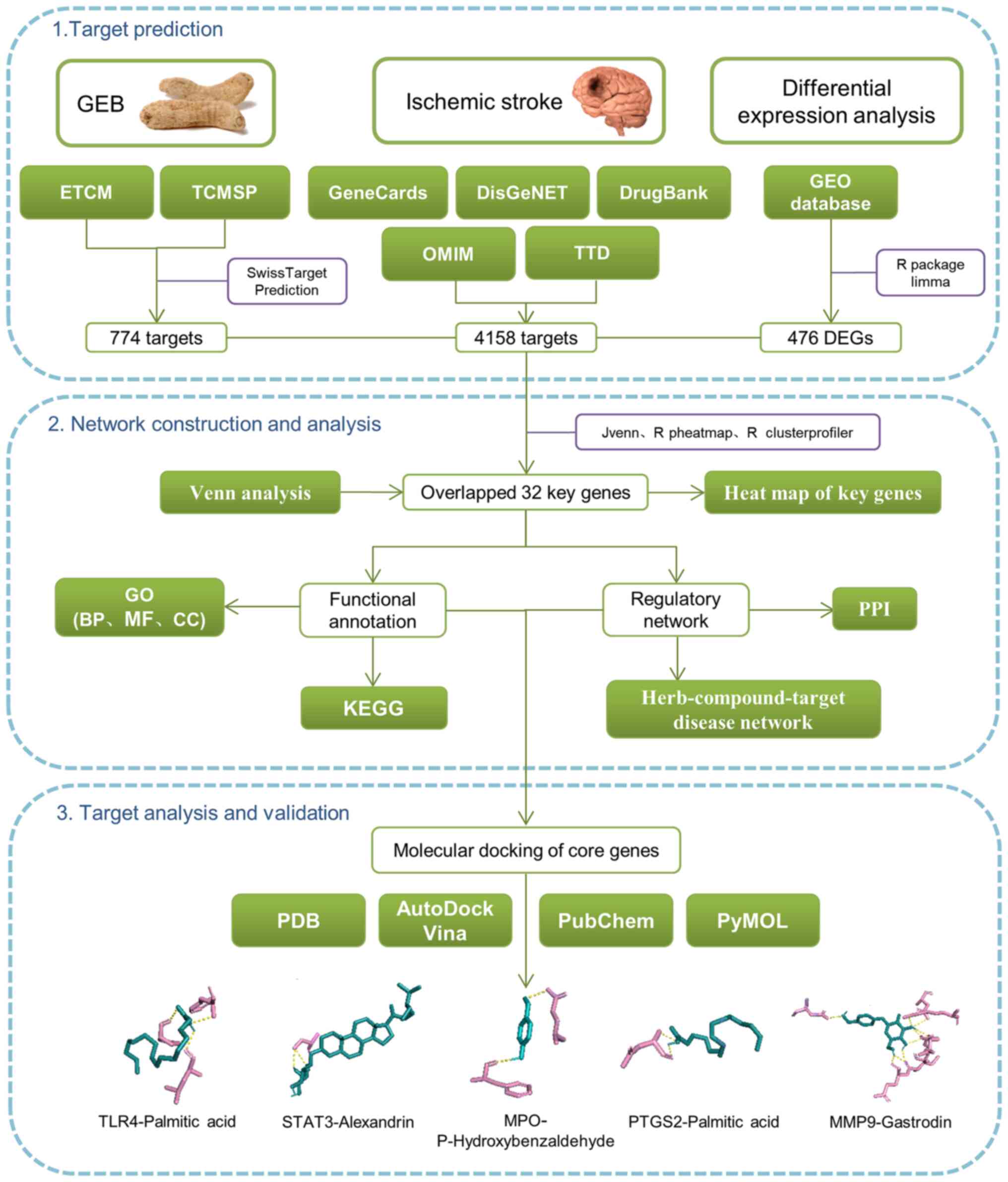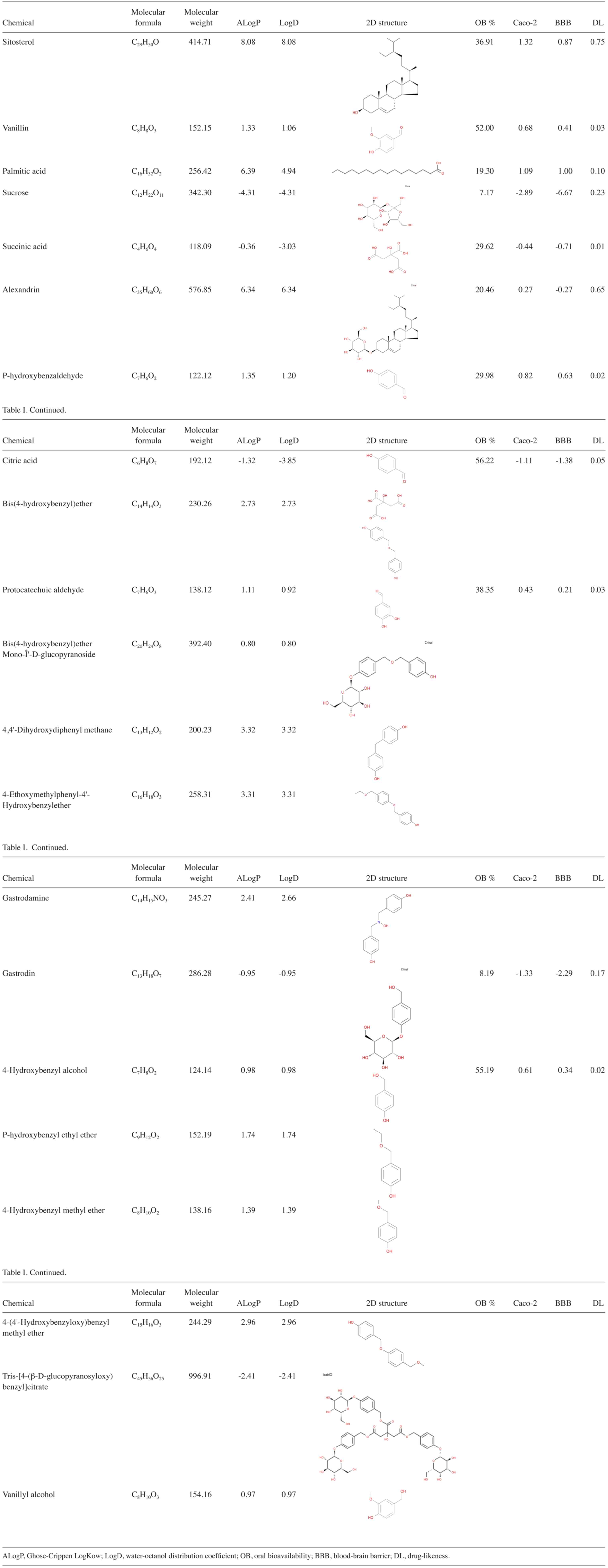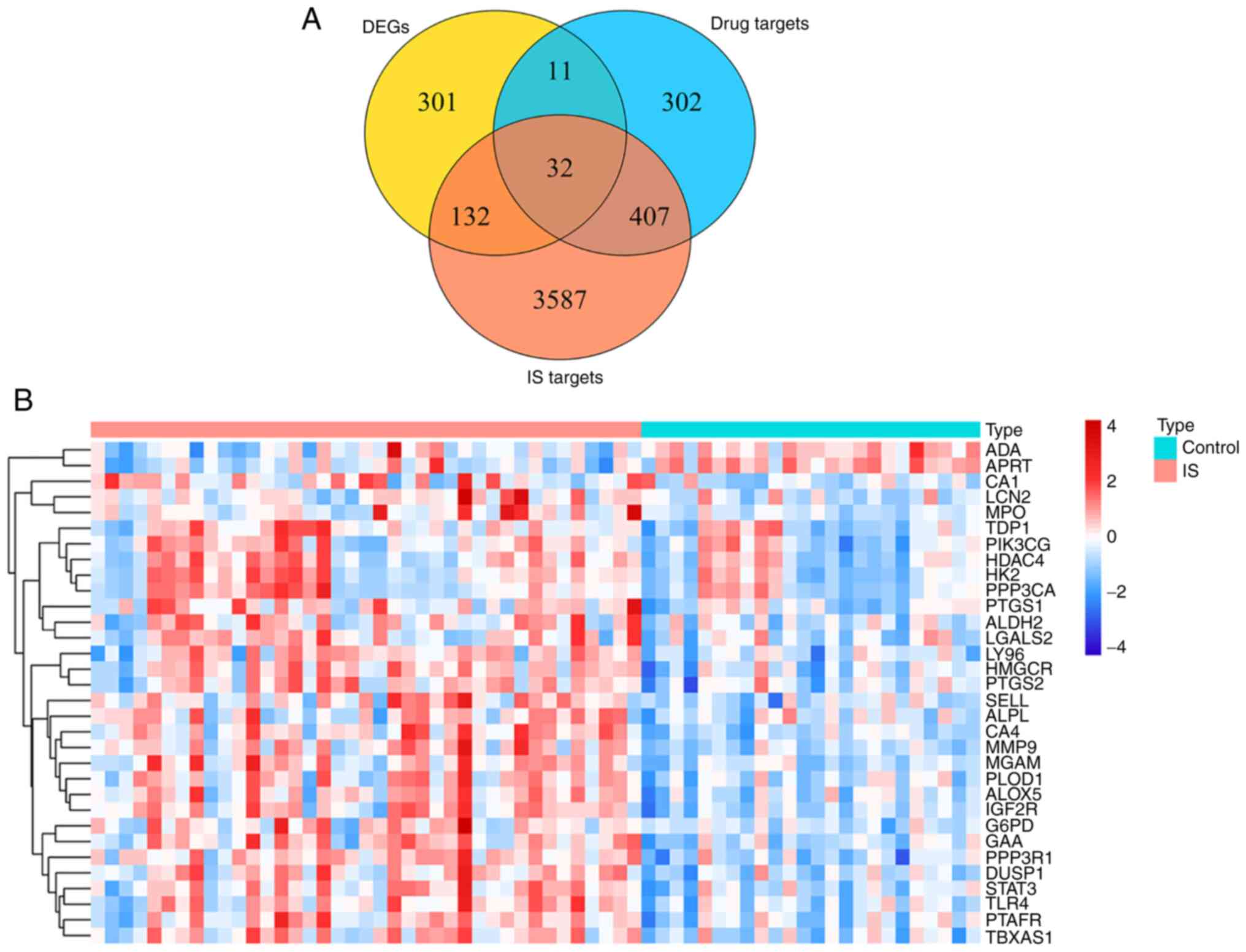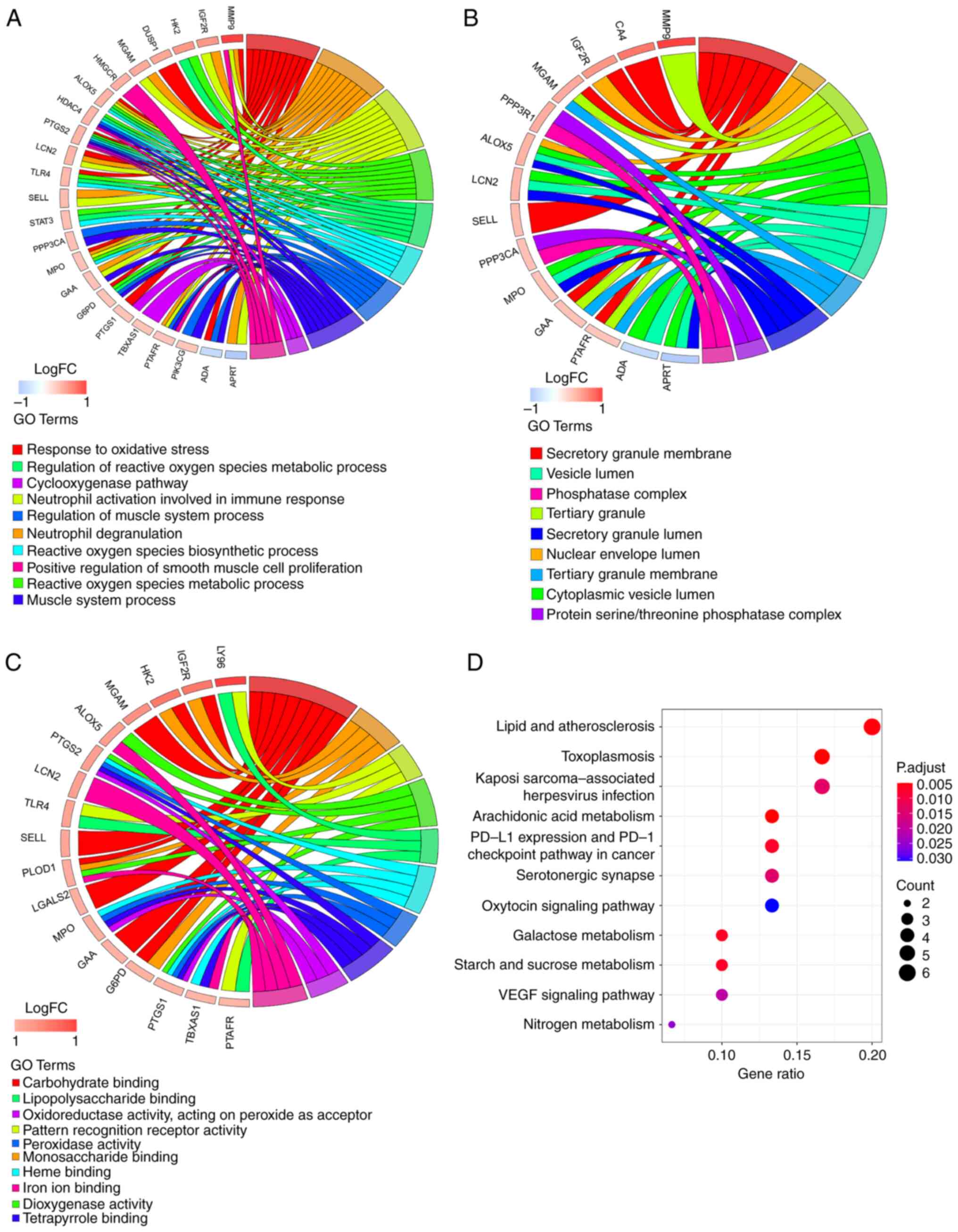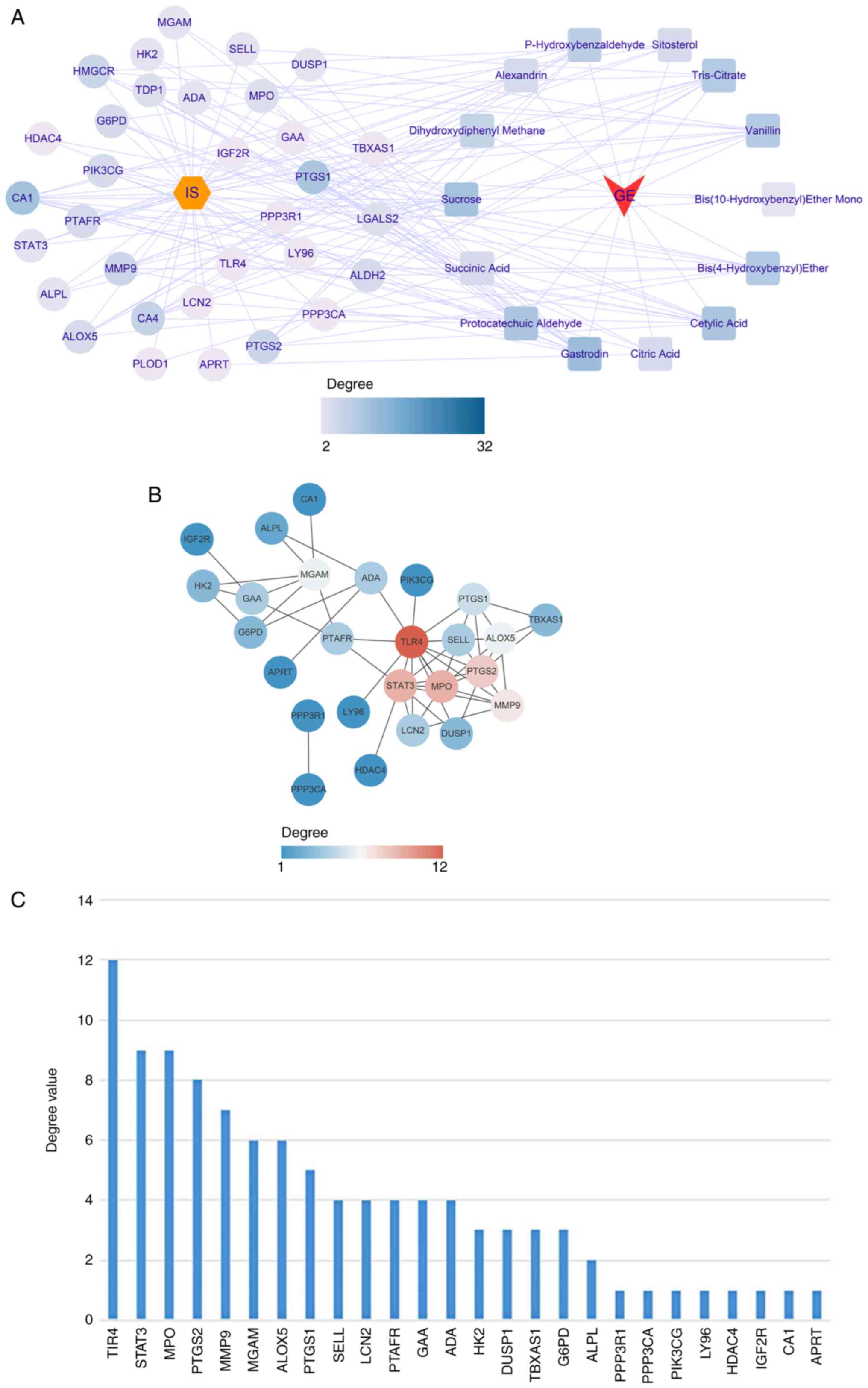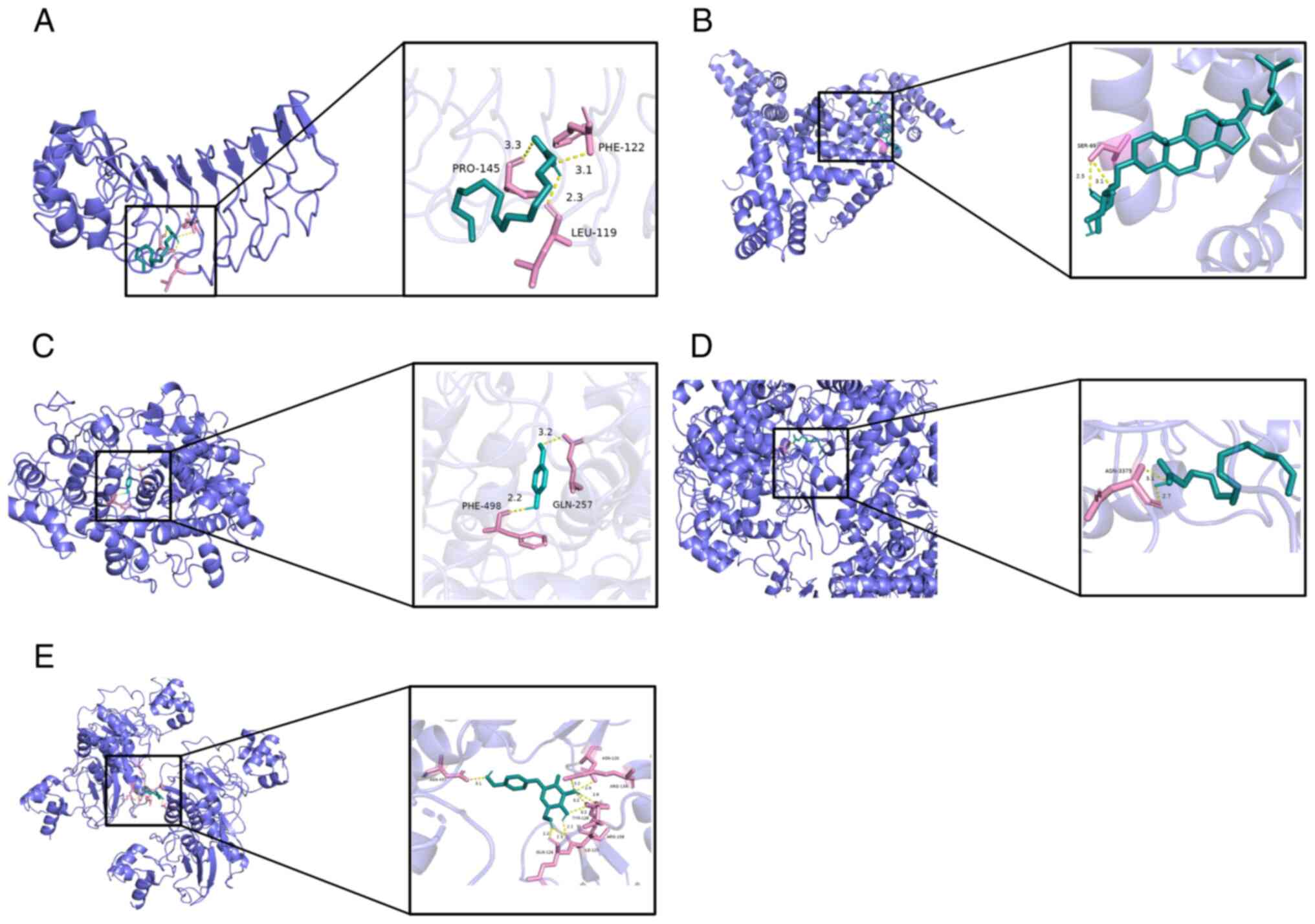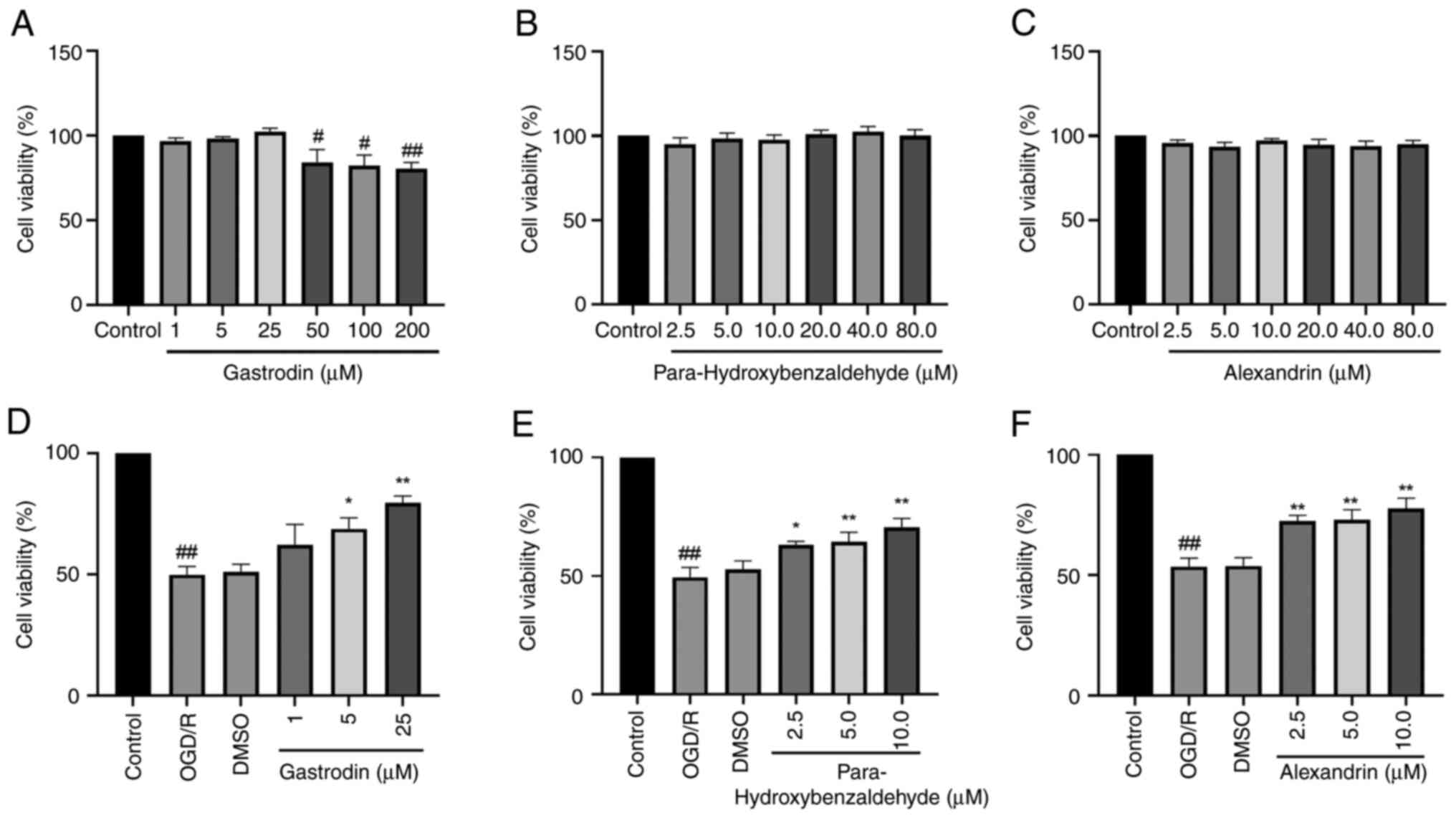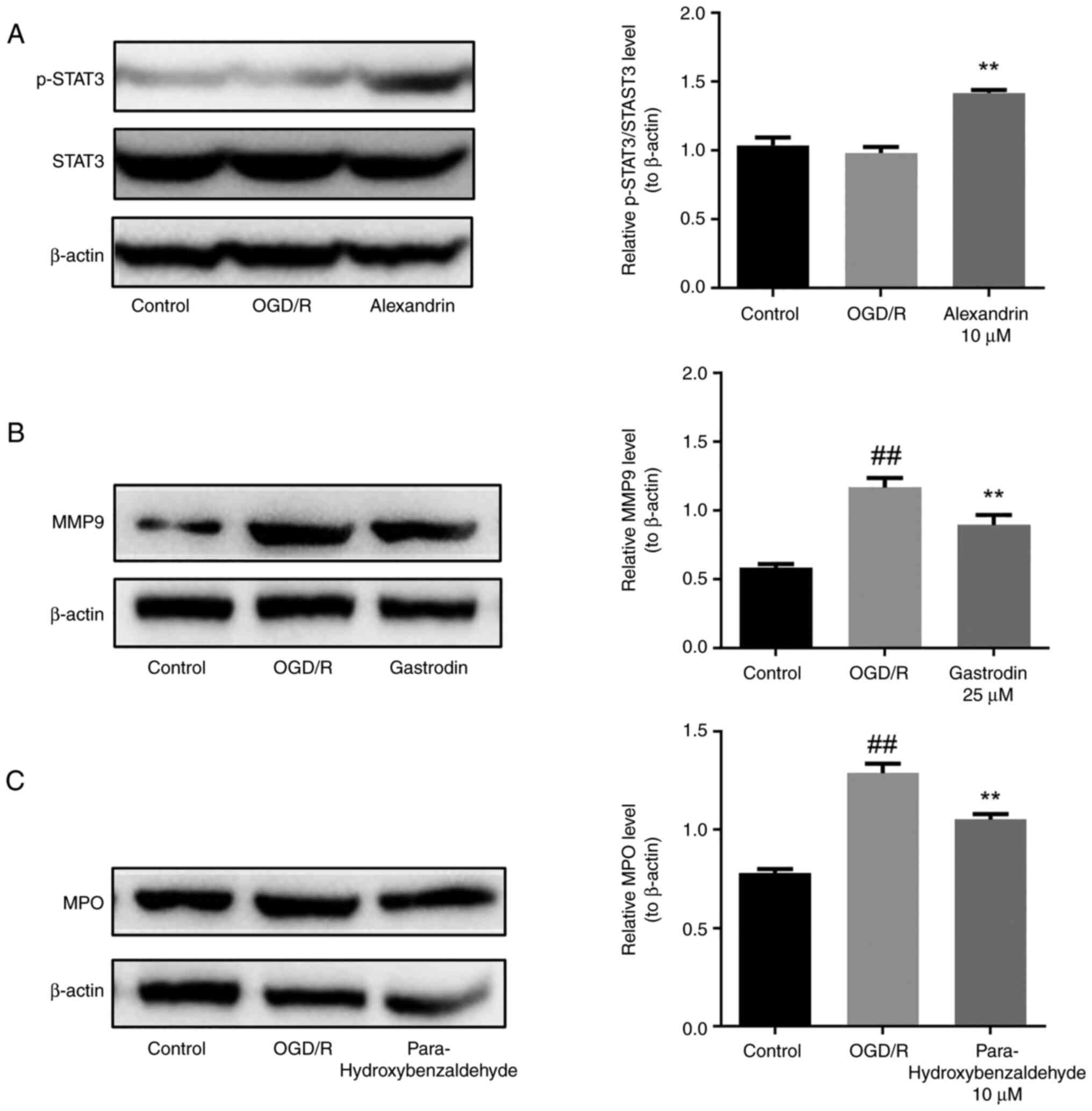|
1
|
Kuklina EV, Tong X, George MG and Bansil
P: Epidemiology and prevention of stroke: A worldwide perspective.
Expert Rev Neurother. 12:199–208. 2012.PubMed/NCBI View Article : Google Scholar
|
|
2
|
GBD 2016 Neurology Collaborators. Global,
regional, and national burden of neurological disorders, 1990-2016:
A systematic analysis for the global burden of disease study 2016.
Lancet Neurol. 18:459–480. 2019.PubMed/NCBI View Article : Google Scholar
|
|
3
|
Mendelson SJ and Prabhakaran S: Diagnosis
and management of transient ischemic attack and acute ischemic
stroke: A review. JAMA. 325:1088–1098. 2021.PubMed/NCBI View Article : Google Scholar
|
|
4
|
Paul S and Candelario-Jalil E: Emerging
neuroprotective strategies for the treatment of ischemic stroke: An
overview of clinical and preclinical studies. Exp Neurol.
335(113518)2021.PubMed/NCBI View Article : Google Scholar
|
|
5
|
Zhang C, Liao Y, Liu L, Sun Y, Lin S, Lan
J, Mao H, Chen H and Zhao Y: A network pharmacology approach to
investigate the active compounds and mechanisms of musk for
ischemic stroke. Evid Based Complement Alternat Med.
2020(4063180)2020.PubMed/NCBI View Article : Google Scholar
|
|
6
|
Chavez LM, Huang SS, MacDonald I, Lin JG,
Lee YC and Chen YH: Mechanisms of acupuncture therapy in ischemic
stroke rehabilitation: A literature review of basic studies. Int J
Mol Sci. 18(2270)2017.PubMed/NCBI View Article : Google Scholar
|
|
7
|
Venketasubramanian N: Complementary and
alternative interventions for stroke recovery-a narrative overview
of the published evidence. J Complement Integr Med. 18:553–559.
2021.PubMed/NCBI View Article : Google Scholar
|
|
8
|
Han SY, Hong ZY, Xie YH, Zhao Y and Xu X:
Therapeutic effect of Chinese herbal medicines for post stroke
recovery: A traditional and network meta-analysis. Medicine
(Baltimore). 96(e8830)2017.PubMed/NCBI View Article : Google Scholar
|
|
9
|
Hsieh CL, Chiang SY, Cheng KS, Lin YH,
Tang NY, Lee CJ, Pon CZ and Hsieh CT: Anticonvulsive and free
radical scavenging activities of Gastrodia elata Bl. in
kainic acid-treated rats. Am J Chin Med. 29:331–341.
2001.PubMed/NCBI View Article : Google Scholar
|
|
10
|
Zhu H, Liu C, Hou J, Long H, Wang B, Guo
D, Lei M and Wu W: Gastrodia elata Blume polysaccharides: A
review of their acquisition, analysis, modification, and
pharmacological activities. Molecules. 24(2436)2019.PubMed/NCBI View Article : Google Scholar
|
|
11
|
Wang ZH, Chen BH, Lin YY, Xing J, Wei ZL
and Ren L: Herbal decoction of Gastrodia, Uncaria, and Curcuma
confers neuroprotection against cerebral ischemia in vitro and in
vivo. J Integr Neurosci. 19:513–519. 2020.PubMed/NCBI View Article : Google Scholar
|
|
12
|
Xu N, Li M, Wang P, Wang S and Shi H:
Spectrum-effect relationship between antioxidant and
anti-inflammatory effects of banxia baizhu tianma decoction: An
identification method of active substances with endothelial cell
protective effect. Front Pharmacol. 13(823341)2022.PubMed/NCBI View Article : Google Scholar
|
|
13
|
He KL, Zhang P and Liu XL: Tianma
injection in the treatment of vertebral basilar artery
insufficiency randomized parallel group study. J Pract Tradit Chin
Intern Med. 28:44–46. 2014.
|
|
14
|
Tang X, Lu J, Chen H, Zhai L, Zhang Y, Lou
H, Wang Y, Sun L and Song B: Underlying mechanism and active
ingredients of tianma gouteng acting on cerebral infarction as
determined via network pharmacology analysis combined with
experimental validation. Front Pharmacol. 12(760503)2021.PubMed/NCBI View Article : Google Scholar
|
|
15
|
Duan X, Wang W, Liu X, Yan H, Dai R and
Lin Q: Neuroprotective effect of ethyl acetate extract from
Gastrodia elata against transient focal cerebral ischemia in
rats induced by middle cerebral artery occlusion. J Tradit Chin
Med. 35:671–678. 2015.PubMed/NCBI View Article : Google Scholar
|
|
16
|
He F, Duan X, Dai R, Wang W, Yang C and
Lin Q: Protective effects of Ethyl acetate extraction from
Gastrodia elata Blume on blood-brain barrier in focal
cerebral ischemia reperfusion. Afr J Tradit Complement Altern Med.
13:199–209. 2016.PubMed/NCBI View Article : Google Scholar
|
|
17
|
Wang T, Chen H, Xia S, Chen X, Sun H and
Xu Z: Ameliorative effect of parishin C against cerebral
ischemia-induced brain tissue injury by reducing oxidative stress
and inflammatory responses in rat model. Neuropsychiatr Dis Treat.
17:1811–1823. 2021.PubMed/NCBI View Article : Google Scholar
|
|
18
|
Ruan Y, Yao L, Zhang B, Zhang S and Guo J:
Nanoparticle-mediated delivery of neurotoxin-II to the brain with
intranasal administration: An effective strategy to improve
antinociceptive activity of neurotoxin. Drug Dev Ind Pharm.
38:123–128. 2012.PubMed/NCBI View Article : Google Scholar
|
|
19
|
Nogales C, Mamdouh ZM, List M, Kiel C,
Casas AI and Schmidt HHHW: Network pharmacology: Curing causal
mechanisms instead of treating symptoms. Trends Pharmacol Sci.
43:136–150. 2022.PubMed/NCBI View Article : Google Scholar
|
|
20
|
Zhang R, Zhu X, Bai H and Ning K: Network
pharmacology databases for traditional Chinese medicine: Review and
assessment. Front Pharmacol. 10(123)2019.PubMed/NCBI View Article : Google Scholar
|
|
21
|
Daina A, Michielin O and Zoete V:
SwissTargetPrediction: Updated data and new features for efficient
prediction of protein targets of small molecules. Nucleic Acids
Res. 47 (W1):W357–W364. 2019.PubMed/NCBI View Article : Google Scholar
|
|
22
|
Ritchie ME, Phipson B, Wu D, Hu Y, Law CW,
Shi W and Smyth GK: limma powers differential expression analyses
for RNA-sequencing and microarray studies. Nucleic Acids Res.
43(e47)2015.PubMed/NCBI View Article : Google Scholar
|
|
23
|
Yu G, Wang LG, Han Y and He QY:
clusterProfiler: An R package for comparing biological themes among
gene clusters. OMICS. 16:284–287. 2012.PubMed/NCBI View Article : Google Scholar
|
|
24
|
Otasek D, Morris JH, Bouças J, Pico AR and
Demchak B: Cytoscape automation: Empowering workflow-based network
analysis. Genome Biol. 20(185)2019.PubMed/NCBI View Article : Google Scholar
|
|
25
|
Szklarczyk D, Morris JH, Cook H, Kuhn M,
Wyder S, Simonovic M, Santos A, Doncheva NT, Roth A, Bork P, et al:
The STRING database in 2017: Quality-controlled protein-protein
association networks, made broadly accessible. Nucleic Acids Res.
45 (D1):D362–D368. 2017.PubMed/NCBI View Article : Google Scholar
|
|
26
|
Szklarczyk D, Franceschini A, Wyder S,
Forslund K, Heller D, Huerta-Cepas J, Simonovic M, Roth A, Santos
A, Tsafou KP, et al: STRING v10: Protein-protein interaction
networks, integrated over the tree of life. Nucleic Acids Res. 43
(Database Issue):D447–D452. 2015.PubMed/NCBI View Article : Google Scholar
|
|
27
|
Tang Y, Li M, Wang J, Pan Y and Wu FX:
CytoNCA: A cytoscape plugin for centrality analysis and evaluation
of protein interaction networks. Biosystems. 127:67–72.
2015.PubMed/NCBI View Article : Google Scholar
|
|
28
|
Trott O and Olson AJ: AutoDock Vina:
Improving the speed and accuracy of docking with a new scoring
function, efficient optimization, and multithreading. J Comput
Chem. 31:455–461. 2010.PubMed/NCBI View Article : Google Scholar
|
|
29
|
Seeliger D and de Groot BL: Ligand docking
and binding site analysis with PyMOL and Autodock/Vina. J Comput
Aided Mol Des. 24:417–422. 2010.PubMed/NCBI View Article : Google Scholar
|
|
30
|
Liang Y, Liang B, Wu XR, Chen W and Zhao
LZ: Network pharmacology-based systematic analysis of molecular
mechanisms of dingji fumai decoction for ventricular arrhythmia.
Evid Based Complement Alternat Med. 2021(5535480)2021.PubMed/NCBI View Article : Google Scholar
|
|
31
|
Morris GM, Huey R and Olson AJ: Using
AutoDock for ligand-receptor docking. Curr Protoc Bioinformatics
Chapter 8. Unit 8.14. 2008.PubMed/NCBI View Article : Google Scholar
|
|
32
|
Yang Y, He Y, Wei X, Wan H, Ding Z, Yang J
and Zhou H: Network pharmacology and molecular docking-based
mechanism study to reveal the protective effect of salvianolic acid
C in a rat model of ischemic stroke. Front Pharmacol.
12(799448)2022.PubMed/NCBI View Article : Google Scholar
|
|
33
|
Ito K and Murphy D: Application of ggplot2
to pharmacometric graphics. CPT Pharmacometrics Syst Pharmacol.
2(e79)2013.PubMed/NCBI View Article : Google Scholar
|
|
34
|
Le TT and Moore JH: treeheatr: An R
package for interpretable decision tree visualizations.
Bioinformatics. 37:282–284. 2021.PubMed/NCBI View Article : Google Scholar
|
|
35
|
Walter W, Sanchez-Cabo F and Ricote M:
GOplot: An R package for visually combining expression data with
functional analysis. Bioinformatics. 31:2912–2914. 2015.PubMed/NCBI View Article : Google Scholar
|
|
36
|
Jiang LH, Yang NY, Yuan XL, Zou YJ, Zhao
FM, Chen JP, Wang MY and Lu DX: Daucosterol promotes the
proliferation of neural stem cells. J Steroid Biochem Mol Biol.
140:90–99. 2014.PubMed/NCBI View Article : Google Scholar
|
|
37
|
Jiang T, Cheng H, Su J, Wang X, Wang Q,
Chu J and Li Q: Gastrodin protects against glutamate-induced
ferroptosis in HT-22 cells through Nrf2/HO-1 signaling pathway.
Toxicol In Vitro. 62(104715)2020.PubMed/NCBI View Article : Google Scholar
|
|
38
|
Xiang B, Chun X, Shen T, Jiang S, Lin Q
and Li XF: 4-hydroxybenzyl aldehyde can prevent the acute cerebral
ischemic injury in rats. Chin Tradit Pat Med. 39:1572–1576.
2017.(In Chinese).
|
|
39
|
Xiong H, Dong Z, Lou G, Gan Q, Wang J and
Huang Q: Analysis of the mechanism of Shufeng Jiedu capsule
prevention and treatment for COVID-19 by network pharmacology
tools. Eur J Integr Med. 40(101241)2020.PubMed/NCBI View Article : Google Scholar
|
|
40
|
Heese K: Gastrodia elata Blume
(Tianma): Hope for brain aging and dementia. Evid Based Complement
Alternat Med. 2020(8870148)2020.PubMed/NCBI View Article : Google Scholar
|
|
41
|
Xia C, Zhou H, Xu X, Jiang T, Li S, Wang
D, Nie Z and Sheng Q: Identification and investigation of miRNAs
From Gastrodia elata Blume and their potential function.
Front Pharmacol. 11(542405)2020.PubMed/NCBI View Article : Google Scholar
|
|
42
|
Jurcau A and Ardelean IA: Molecular
pathophysiological mechanisms of ischemia/reperfusion injuries
after recanalization therapy for acute ischemic stroke. J Integr
Neurosci. 20:727–744. 2021.PubMed/NCBI View Article : Google Scholar
|
|
43
|
Wang X, Wang ZY, Zheng JH and Li S: TCM
network pharmacology: A new trend towards combining computational,
experimental and clinical approaches. Chin J Nat Med. 19:1–11.
2021.PubMed/NCBI View Article : Google Scholar
|
|
44
|
Khatana C, Saini NK, Chakrabarti S, Saini
V, Sharma A, Saini RV and Saini AK: Mechanistic insights into the
oxidized low-density lipoprotein-induced atherosclerosis. Oxid Med
Cell Longev. 2020(5245308)2020.PubMed/NCBI View Article : Google Scholar
|
|
45
|
Chow YL, Teh LK, Chyi LH, Lim LF, Yee CC
and Wei LK: Lipid metabolism genes in stroke pathogenesis: The
atherosclerosis. Curr Pharm Des. 26:4261–4271. 2020.PubMed/NCBI View Article : Google Scholar
|
|
46
|
Adibhatla RM and Hatcher JF: Altered lipid
metabolism in brain injury and disorders. Subcell Biochem.
49:241–268. 2008.PubMed/NCBI View Article : Google Scholar
|
|
47
|
Wang B, Wu L, Chen J, Dong L, Chen C, Wen
Z, Hu J, Fleming I and Wang DW: Metabolism pathways of arachidonic
acids: Mechanisms and potential therapeutic targets. Signal
Transduct Target Ther. 6(94)2021.PubMed/NCBI View Article : Google Scholar
|
|
48
|
Anrather J and Iadecola C: Inflammation
and stroke: An overview. Neurotherapeutics. 13:661–670.
2016.PubMed/NCBI View Article : Google Scholar
|
|
49
|
Ai L, Xu A and Xu J: Roles of PD-1/PD-L1
pathway: Signaling, cancer, and beyond. Adv Exp Med Biol.
1248:33–59. 2020.PubMed/NCBI View Article : Google Scholar
|
|
50
|
Schütz F, Stefanovic S, Mayer L, von Au A,
Domschke C and Sohn C: PD-1/PD-L1 pathway in breast cancer. Oncol
Res Treat. 40:294–297. 2017.PubMed/NCBI View Article : Google Scholar
|
|
51
|
Jiang LH, Yuan XL, Yang NY, Ren L, Zhao
FM, Luo BX, Bian YY, Xu JY, Lu DX, Zheng YY, et al: Daucosterol
protects neurons against oxygen-glucose
deprivation/reperfusion-mediated injury by activating IGF1
signaling pathway. J Steroid Biochem Mol Biol. 152:45–52.
2015.PubMed/NCBI View Article : Google Scholar
|
|
52
|
Gao GS, Li Y, Zhai H, Bi JW, Zhang FS,
Zhang XY and Fan SH: Humanin analogue, S14G-humanin, has
neuroprotective effects against oxygen glucose
deprivation/reoxygenation by reactivating Jak2/Stat3 signaling
through the PI3K/AKT pathway. Exp Ther Med. 14:3926–3934.
2017.PubMed/NCBI View Article : Google Scholar
|
|
53
|
Zhang Z and Yang W: Paeoniflorin protects
PC12 cells from oxygen-glucose deprivation/reoxygenation-induced
injury via activating JAK2/STAT3 signaling. Exp Ther Med.
21(572)2021.PubMed/NCBI View Article : Google Scholar
|
|
54
|
Lei JR, Tu XK, Wang Y, Tu DW and Shi SS:
Resveratrol downregulates the TLR4 signaling pathway to reduce
brain damage in a rat model of focal cerebral ischemia. Exp Ther
Med. 17:3215–3221. 2019.PubMed/NCBI View Article : Google Scholar
|
|
55
|
Chen S, Chen H, Du Q and Shen J: Targeting
myeloperoxidase (MPO) mediated oxidative stress and inflammation
for reducing brain ischemia injury: Potential application of
natural compounds. Front Physiol. 11(433)2020.PubMed/NCBI View Article : Google Scholar
|
|
56
|
Zhu YP, Li X, Du Y, Zhang L, Ran L and
Zhou NN: Protective effect and mechanism of p-hydroxybenzaldehyde
on blood-brain barrier. Zhongguo Zhong Yao Za Zhi. 43:1021–1027.
2018.PubMed/NCBI View Article : Google Scholar : (In Chinese).
|
|
57
|
Chen KY, Chen YJ, Cheng CJ, Jhan KY, Chiu
CH and Wang LC: 3-hydroxybenzaldehyde and 4-hydroxybenzaldehyde
enhance survival of mouse astrocytes treated with angiostrongylus
cantonensis young adults excretory/secretory products. Biomed J. 44
(6 Suppl 2):S258–S266. 2021.PubMed/NCBI View Article : Google Scholar
|
|
58
|
Jang JH, Son Y, Kang SS, Bae CS, Kim JC,
Kim SH, Shin T and Moon C: Neuropharmacological potential of
Gastrodia elata Blume and its components. Evid Based
Complement Alternat Med. 2015(309261)2015.PubMed/NCBI View Article : Google Scholar
|
|
59
|
Tao J, Luo ZY, Msangi CI, Shu XS, Wen L,
Liu SP, Zhou CQ, Liu RX and Hu WX: Relationships among genetic
makeup, active ingredient content, and place of origin of the
medicinal plant Gastrodia tuber. Biochem Genet. 47:8–18.
2009.PubMed/NCBI View Article : Google Scholar
|
|
60
|
Liu Y, Gao J, Peng M, Meng H, Ma H, Cai P,
Xu Y, Zhao Q and Si G: A review on central nervous system effects
of gastrodin. Front Pharmacol. 9(24)2018.PubMed/NCBI View Article : Google Scholar
|
|
61
|
Li S, Bian L, Fu X, Ai Q, Sui Y, Zhang A,
Gao H, Zhong L and Lu D: Gastrodin pretreatment alleviates rat
brain injury caused by cerebral ischemic-reperfusion. Brain Res.
1712:207–216. 2019.PubMed/NCBI View Article : Google Scholar
|
|
62
|
Wang J and Wu M: The up-regulation of
miR-21 by gastrodin to promote the angiogenesis ability of human
umbilical vein endothelial cells by activating the signaling
pathway of PI3K/Akt. Bioengineered. 12:5402–5410. 2021.PubMed/NCBI View Article : Google Scholar
|
|
63
|
Zhang ZL, Gao YG, Zang P, Gu PP, Zhao Y,
He ZM and Zhu HY: Research progress on mechanism of gastrodin and
p-hydroxybenzyl alcohol on central nervous system. Zhongguo Zhong
Yao Za Zhi. 45:312–320. 2020.PubMed/NCBI View Article : Google Scholar : (In Chinese).
|
|
64
|
Peng Z, Wang S, Chen G, Cai M, Liu R, Deng
J, Liu J, Zhang T, Tan Q and Hai C: Gastrodin alleviates cerebral
ischemic damage in mice by improving anti-oxidant and
anti-inflammation activities and inhibiting apoptosis pathway.
Neurochem Res. 40:661–673. 2015.PubMed/NCBI View Article : Google Scholar
|
|
65
|
Yuan H, Ma Q, Cui H, Liu G, Zhao X, Li W
and Piao G: How can synergism of traditional medicines benefit from
network pharmacology? Molecules. 22(1135)2017.PubMed/NCBI View Article : Google Scholar
|















